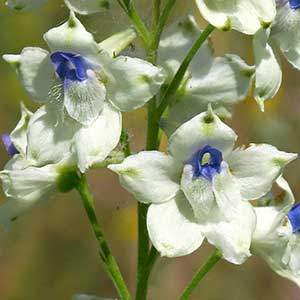Delphinium nuttallii subsp. ochroleucum
(synonym of Delphinium leucophaeum)
Delphinium sapellonis
pale larkspur, white rock larkspur
Sapello Canyon larkspur
30-60 cm.
(50-)100-180(-220) cm;
base sometimes reddish, glabrous sometimes glaucous.
blade round to pentagonal, 6-10 × 8-16 cm, nearly glabrous; ultimate lobes 5-15, width 5-25 mm.
(12-)30-80(-120)-flowered;
pedicel 0.5-2 cm, glandular-puberulent;
bracteoles 3-5 mm from flowers, green to purple, linear, 5-8 mm, glandular-puberulent.
sepals white or light yellow, spurs 9-11 mm;
lower petal blades 4-6 mm.
sepals (in bud) yellowish or brownish purple, becoming browner or yellower with age, glandular-puberulent, lateral sepals forward pointing, 8-12 × 3-5 mm, spurs straight, ascending 20-45° above horizontal, 8-11 mm;
lower petal blades slightly elevated, ± exposing stamens, 2.5-5 mm, clefts 1-2 mm;
hairs centered, mostly above base of cleft, yellow.
12-18 mm, 3-4 times longer than wide, puberulent.
wing-margined;
seed coat cells elongate, surfaces smooth.
= 16.
Delphinium nuttallii subsp. ochroleucum
Delphinium sapellonis
Of conservation concern.
The range of morphologic features of Delphinium nuttallii subsp. ochroleucum (D. leucophaeum) is almost completely encompassed within that of D. nuttallii subsp. nuttallii. Sepal color is the only feature consistently separating the two subspecies. Were it not for the fact that any given population typically has plants of only one flower color, a rank of forma would be more appropriate.
(Discussion copyrighted by Flora of North America; reprinted with permission.)
Delphinium sapellonis hybridizes with D. barbeyi and D. robustum. It replaces D. robustum and represents the southern Cordilleran complex at higher elevations of the southern Sangre de Cristo Mountains east of Santa Fe. It is not known elsewhere.
(Discussion copyrighted by Flora of North America; reprinted with permission.)


